 images from our report on high schools and read more education coverage here.” width=”600″ height=”400″>
images from our report on high schools and read more education coverage here.” width=”600″ height=”400″>
Photo by: Jarrett Murphy
Freddie Perez (left) and Jonathon DeLaTorre seen in 2007 at South Brooklyn Community High School, which offers an alternative to traditional high school settings. See more images from our report on high schools and read more education coverage here.
In the U.S. Department of Education’s new “A Blueprint for Reform: The Reauthorization of the Elementary and Secondary Education Act”, school closure is one of the specific strategies school districts are encouraged to consider as they contemplate strategies for addressing chronically failing schools. For several years now, the New York City Department of Education (DOE) has used school closure as a central element of its reform strategy and by June 2012 the city will have closed a total of 94 schools since 2012.
In late March, State Supreme Court Justice Joan B. Lobis halted, at least temporarily, the closing of an additional 19 schools, ruling that the DOE did not provide adequate analysis and information to the public related to the impact that the closings would have on communities.
The court’s ruling is a significant setback for Mayor Bloomberg, who won control over New York’s schools in 2002, and Chancellor Joel Klein. Under their leadership, many schools have improved, but there have also been mixed results on a variety of important indicators.
State test scores for third, fifth and eighth graders have risen significantly, but gains in scores on the federal National Assessment of Education Progress—or NAEP, also called the nation’s report card, which most experts regard as a more reliable indicator of student performance—have been less impressive.
There has been a steady increase in graduation rates, but last year 50 percent of New York City graduates admitted to CUNY colleges were required to enroll in remedial courses, effectively repeating classes they were supposed to have taken and passed while in high school. Finally, for black and Latino males, no more than 50 percent of the class of 2009 graduated within four years. A third of those who did graduate received the less-rigorous local diploma, rather than a Regents diploma—the higher standard that all graduates will have to meet when the local diploma is phased out in 2012.
We have studied and worked closely with schools throughout New York City for the last eight years and have tried to be fair in our assessment of the progress achieved. The school closure strategy is one of the policies we believe has exposed a crucial weakness in the DOE’s approach to reform. Our analysis of schools in New York City leaves us to believe that the court was right to stop the current round of closures because the DOE has not made clear how this strategy will lead to better schools for the most vulnerable students.
A disproportionate number of students in the schools targeted for closure are among the most educationally disadvantaged and vulnerable students in the city: English language learners, students with severe learning disabilities, students who are academically behind when they enter high school. Several studies have shown that an over-concentration of these students in particular schools has significantly increased the likelihood that they will be labeled failing and targeted for closure. Unless something is done to prevent this from occurring again the schools that absorb these students are likely to fail as well.
All of the 19 schools identified by the DOE to be closed (whose students are 94 percent black or Latino) serve an extremely high proportion of at-risk students. An average of 10 percent of students in the schools have limited English proficiency, 18 percent are in special education and 11 percent are over-age for their grade level. Among the high schools, large numbers of students enter the ninth grade below grade level and many of the targeted schools serve a higher proportion of self-contained special education students. Finally, many of the schools receive high numbers of transfer students throughout the school year. A large number of these students have weak or interrupted educational backgrounds and the schools lack the resources to provide the support and remediation they need.
The rationale behind the phase-out of failing schools is that students will be better served in new schools and that tough accountability will motivate all schools to improve. But the DOE has not put forward a strategy to support schools that serve a disproportionate number of high-need students, nor does it guarantee that the displaced students will be admitted to higher-performing schools. Over the last eight years, the DOE has increased the number of schools that are allowed to screen students based on achievement. It has also actively encouraged the development and expansion of charter schools, many of which also serve a low percentage of high-need students. Such policies have resulted in a smaller number of schools serving the most disadvantaged students, and not surprisingly, many of those schools are struggling.
School closure may be necessary in some cases, but it should be the last resort after a careful assessment to determine the causes of failure. The court’s ruling should serve as an opportunity for the DOE to reflect on its strategy and for the U.S. Department of Education to learn. If our educational leaders are serious about producing sustainable improvements in our nation’s schools they will need a strategy to help schools improve rather than merely shut them down.
Ben Meade contributed to this City Conversations piece. The authors are on the faculty of New York University’s Steinhardt School.
To read the DOE’s published response to critics of its closures, click here.








